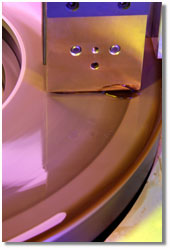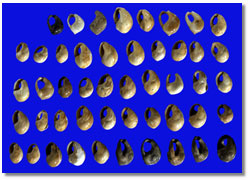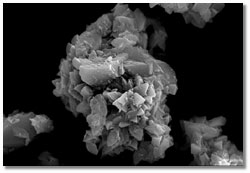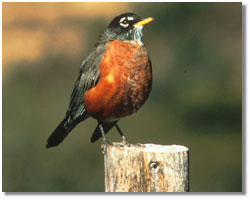 |

|
 |
 |
A close-up of the machine in action. The dark brown rings on the rotating abrasive wheel are from the "lapping swarf." The swarf is a mixture of the Ventana fluid and ceramic debris particles from the read-write head specimen. During the process, the researchers add the Ventana fluid drop by drop onto the rotating wheel. Centripetal acceleration causes the swarf to move to the outer edge of the rotating wheel.
Credit: Erica von Koerber, Evon Photography
|
Yet Another Benefit of Green Tea—New, Biodegradable Machining Compound is More Effective than Industry Standards
Derived in part from green tea, a new biodegradable machining compound for computer hard drive manufacturing is three to four times more effective than toxic counterparts. In an industry where more than 161 million hard drives leave assembly lines each year, the new compound could significantly improve manufacturing efficiency and minimize environmental risks. Engineered by John Lombardi of Ventana Research Corporation in Tucson, Ariz., as part of a National Science Foundation Small Business Innovation Research grant, the chemical is part of a slurry that polishes the ceramics—made from aluminum oxide and titanium carbide—used in computer hard drive read-write heads.
More...
(posted April 23, 2004)
|
 |
|
 |
Nassarius shell beads from Blombos Cave, an archaeological site on the South African coast, are 75,000 years old.
Credit: C. Henshilwood & F. d'Errico
|
Shell Beads from South African Cave Show Modern Human Behavior 75,000 Years Ago
Perforated shells found at South Africa's Blombos Cave appear to have been strung as beads about 75,000 years ago-making them 30,000 years older than any previously identified personal ornaments. Archaeologists excavating the site on the coast of the Indian Ocean discovered 41 shells, all with holes and wear marks in similar positions, in a layer of sediment deposited during the Middle Stone Age. "The Blombos Cave beads present absolute evidence for perhaps the earliest storage of information outside the human brain," says Christopher Henshilwood, program director of the Blombos Cave Project and professor at the Centre for Development Studies of the University of Bergen in Norway.
More...
(posted April 23, 2004)
|
 |
|
 |
Scanning electron micrograph of NanoActive Magnesium Oxide Plus. The material's large surface area gives it the ability to capture and destroy toxic chemicals. Just 25 grams (a little less than an ounce) has the surface area of almost three NFL football fields.
Credit: NanoScale Materials, Inc.
|
Nano-Engineered Product Neutralizes Chemical Hazards
Researchers at NanoScale Materials, Inc., have developed scaled-up production processes for FAST-ACT (First Applied Sorbent Treatment Against Chemical Threats), an advanced nano-engineered family of products designed to provide first responders, hazmat teams and other emergency personnel with a single technology to counteract a variety of chemical warfare agents and toxic industrial chemicals. Non-toxic, non-corrosive and non-flammable, FAST-ACT is particularly useful when response personnel are confronted with a chemical spill whose exact nature is unknown.
More... (posted
April 23, 2004)

 |
Turdus migratorius, a.k.a. the American robin
Credit: Art Biale, Cornell Lab of Ornithology
|
eBird Lists "Most Wanted" for the Spring Migration
Wanted: Branta bernicla, a.k.a. the Brant, for poorly understood movements across North America from northern Canada and Alaska to Mexico. The Brant—a small, dark goose vulnerable to declines in its various coastal populations—tops this year's Spring Migration Top 10 "Most Wanted" list, recently posted by eBird. This high-tech web portal lets birders everywhere track their sightings while contributing to the big-picture understanding of North American bird populations.
More... (posted
April 23, 2004)
|
 |
| |


|

